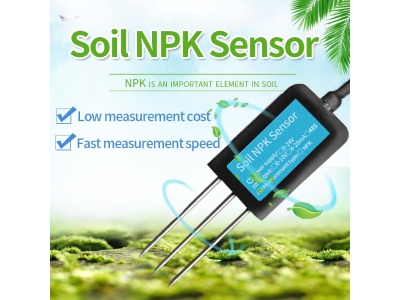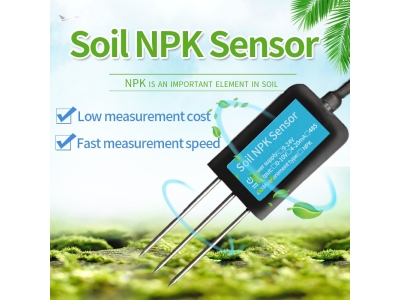In today's rapidly evolving agricultural landscape, farmers face numerous challenges in maximizing crop productivity while minimizing environmental impacts. One critical factor in achieving this delicate balance is the management of soil health and nutrient levels. Traditional farming practices often involve generalized approaches to irrigation and fertilization, which can result in inefficient resource use and suboptimal crop growth. However, with advancements in technology, specifically soil sensor innovation, farmers now have access to real-time data that can revolutionize their decision-making processes. In this article, we will explore the role of soil sensors in modern agriculture and how they can help maximize crop productivity by providing valuable insights into soil conditions.

Understanding Soil Sensors:
Soil sensors are electronic devices designed to measure various parameters of the soil, including moisture content, pH levels, temperature, nutrient concentrations, and salinity. These sensors are typically embedded in the ground at different depths to capture accurate readings from multiple layers of soil. The data collected by these sensors is then transmitted wirelessly to a central database or cloud platform, where it can be analyzed and used to inform farming practices.
Moisture Sensors:
Moisture sensors play a crucial role in optimizing irrigation practices. By measuring the water content in the soil, farmers can determine when and how much water to apply to their crops. This information helps prevent over or under-watering, ensuring that plants receive the right amount of water for optimal growth and development. Additionally, moisture sensors can provide insights into soil moisture patterns, enabling farmers to identify areas that may require additional drainage or adjustments to irrigation systems.
pH Sensors:
Soil pH directly affects nutrient availability to plants. Different crops have specific pH requirements for optimal growth, and maintaining the correct pH level is essential for nutrient uptake. pH sensors allow farmers to monitor and adjust soil pH levels accordingly, ensuring that nutrients are readily available to plants. By optimizing pH levels, farmers can maximize nutrient absorption, thereby maximizing crop productivity.
Temperature Sensors:
Soil temperature influences seed germination, root growth, and microbial activity. Temperature sensors provide real-time data on soil temperatures, allowing farmers to make informed decisions about planting schedules and other agronomic practices. By understanding the temperature patterns in their fields, farmers can ensure that crops are planted at the most favorable times, resulting in improved germination rates and overall crop performance.
Nutrient Sensors:
Proper nutrient management is crucial for achieving optimal crop yields. Nutrient sensors help farmers monitor the concentration of essential nutrients in the soil, such as nitrogen, phosphorus, and potassium. By measuring these nutrient levels, farmers can apply fertilizers precisely where and when they are needed. This targeted approach minimizes nutrient wastage and reduces the risk of nutrient runoff, which can have detrimental effects on water quality and ecosystems.
Salinity Sensors:
Salinity refers to the salt content in the soil. Excess salts can be harmful to plants, inhibiting their ability to take up water and nutrients. Salinity sensors help farmers identify areas with high salt concentrations, enabling them to implement measures to mitigate the effects of salinity, such as leaching or using salt-tolerant crop varieties. By managing salinity levels effectively, farmers can ensure optimal growing conditions for their crops.
The integration of soil sensors into farming practices offers several significant benefits:
Precision Resource Management: Soil sensors provide farmers with accurate and real-time data on soil conditions, allowing for precise irrigation and fertilization strategies. By tailoring resource applications based on specific soil needs, farmers can optimize resource use, reduce costs, and minimize waste.
Enhanced Crop Health: Soil sensors enable farmers to closely monitor soil moisture levels, pH, temperature, and nutrient concentrations. This information helps identify potential issues early on, allowing for prompt corrective action. By maintaining optimal soil conditions, farmers can promote healthy plant growth, reduce the risk of diseases and pests, and ultimately maximize crop yields.
Environmental Stewardship: By using soil sensors to optimize resource management, farmers can minimize the environmental impacts associated with excessive water usage, nutrient runoff, and chemical leaching. This approach promotes sustainable agricultural practices and helps protect natural resources.
Data-Driven Decision Making: Soil sensors generate vast amounts of data that can be analyzed to gain valuable insights. By integrating soil sensor data with other sources, such as weather data and crop performance records, farmers can make informed decisions about planting schedules, irrigation strategies, and fertilizer applications. This data-driven approach improves overall farm management and productivity.
Challenges and Future Directions:
While soil sensors offer significant benefits, there are challenges that need to be addressed to ensure their widespread adoption and effectiveness:
Cost: Soil sensors can be expensive, especially for small-scale farmers. Efforts should be made to develop affordable options without compromising accuracy and reliability. Government subsidies or collaborative initiatives between technology developers and farming communities could help overcome this barrier.
Data Interpretation: Analyzing and interpreting the large volumes of data generated by soil sensors can be challenging for farmers without technical expertise. User-friendly software tools and decision support systems should be developed to simplify data analysis and provide actionable recommendations.
Integration and Compatibility: To fully harness the potential of soil sensors, seamless integration with existing farm management systems and technologies is crucial. Standardization and compatibility between different sensor brands and data platforms will facilitate data sharing and interoperability.
Education and Training: Farmers need to be educated about the benefits of soil sensors and trained in their proper usage, maintenance, and interpretation of data. Extension services, training programs, and knowledge-sharing platforms can play a vital role in bridging this knowledge gap.
Conclusion:
Soil sensor innovation represents a game-changing technology in modern agriculture. By providing real-time data on soil conditions, these sensors empower farmers to make informed decisions about irrigation, fertilization, and other agronomic practices. The precise management of soil resources leads to enhanced crop health, increased productivity, and reduced environmental impacts. While challenges exist, continued research, development, and collaboration within the agriculture industry will drive the adoption of soil sensors and pave the way for a more sustainable and productive future in farming. By embracing soil sensor technology, farmers can transition from relying on intuition to data-driven decision-making, ultimately maximizing crop productivity and contributing to a more sustainable agricultural sector.






